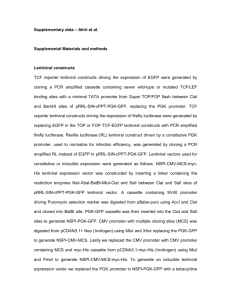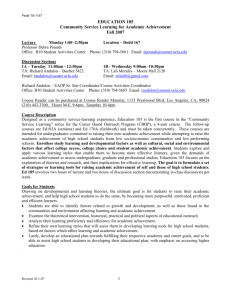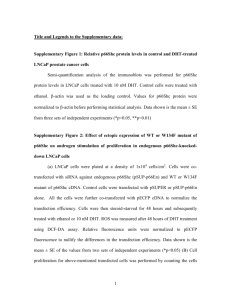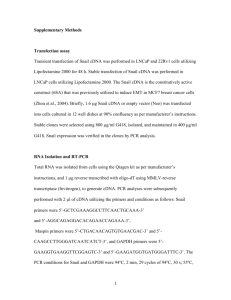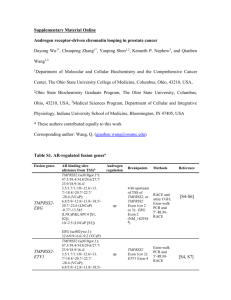Supplemental Figure Legends and Methods
advertisement
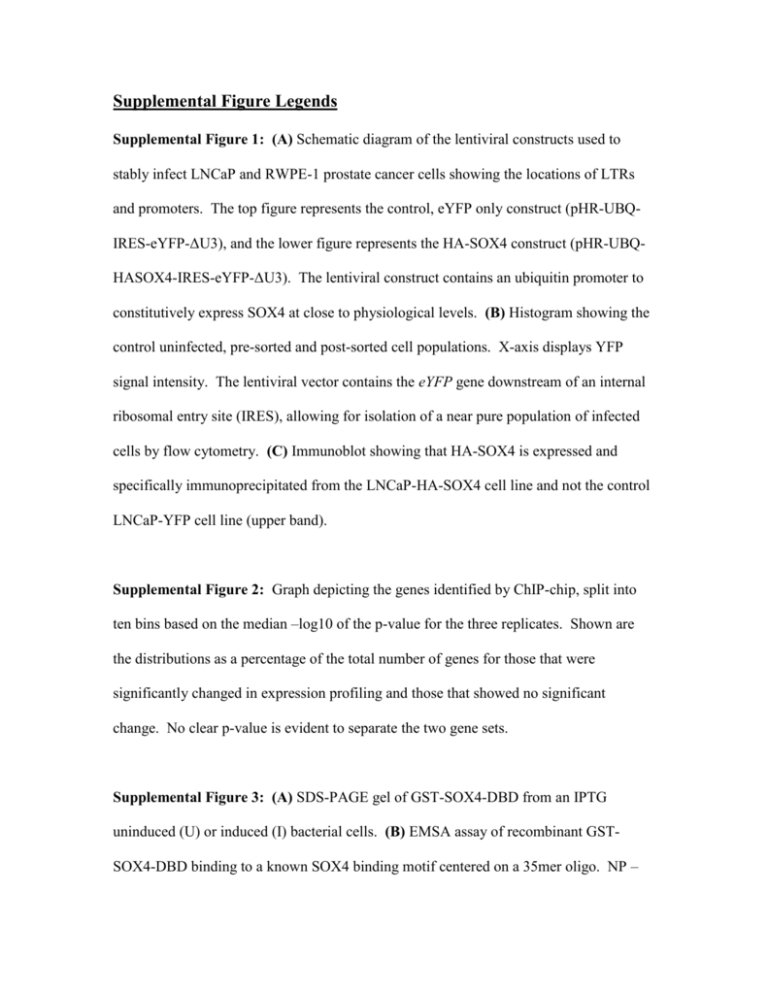
Supplemental Figure Legends Supplemental Figure 1: (A) Schematic diagram of the lentiviral constructs used to stably infect LNCaP and RWPE-1 prostate cancer cells showing the locations of LTRs and promoters. The top figure represents the control, eYFP only construct (pHR-UBQIRES-eYFP-ΔU3), and the lower figure represents the HA-SOX4 construct (pHR-UBQHASOX4-IRES-eYFP-ΔU3). The lentiviral construct contains an ubiquitin promoter to constitutively express SOX4 at close to physiological levels. (B) Histogram showing the control uninfected, pre-sorted and post-sorted cell populations. X-axis displays YFP signal intensity. The lentiviral vector contains the eYFP gene downstream of an internal ribosomal entry site (IRES), allowing for isolation of a near pure population of infected cells by flow cytometry. (C) Immunoblot showing that HA-SOX4 is expressed and specifically immunoprecipitated from the LNCaP-HA-SOX4 cell line and not the control LNCaP-YFP cell line (upper band). Supplemental Figure 2: Graph depicting the genes identified by ChIP-chip, split into ten bins based on the median –log10 of the p-value for the three replicates. Shown are the distributions as a percentage of the total number of genes for those that were significantly changed in expression profiling and those that showed no significant change. No clear p-value is evident to separate the two gene sets. Supplemental Figure 3: (A) SDS-PAGE gel of GST-SOX4-DBD from an IPTG uninduced (U) or induced (I) bacterial cells. (B) EMSA assay of recombinant GSTSOX4-DBD binding to a known SOX4 binding motif centered on a 35mer oligo. NP – no protein, SP – specific probe, SC – specific cold competitor probe, NSC – non-specific cold competitor probe. Supplemental Figure 4: Graph of median frequency of PBM k-mer hits in SOX4 ChIPchip peaks (n = 3600) and random control sequences (n = 3600) for moderate (0.45 > ES > 0.40) and stringent (ES > 0.45) SOX4 k-mers. Significant differences are indicated with an asterisk (*) for stringent k-mers (p = 0.0002) and moderate k-mers (p = 1.08 x 105 ). Supplemental Figure 5: Luciferase assay of LNCaP cells transfected with either a vector control or 100, 200, or 300 ng of a SOX4 expression vector. LNCaP cells were also co-transfected with either a vector control or the β-catenin S33Y constitutively active mutant. All cells were transected with the TOP flash luciferase reporter and luciferase activity was measured 24 hrs post-transfection. SOX4 does not function alone but instead cooperates with β-catenin to activate the TOP flash reporter in a dose dependent manner. Supplemental Figure 6: IPA analysis of Illumina expression genes changed at least 2fold by SAM analysis. SOX4 regulatory targets include a host of membrane and nuclear proteins. Red indicates genes upregulated by SOX4 overexpression and green denotes downregulated genes. Supplemental Methods Cell Line construction To map SOX4 direct targets bound in prostate cancer cells on a genome-wide scale, we took a ChIP-chip approach. To reduce background issues from the FLAG epitope, we generated an HA epitope-tagged SOX4 stable cell line. HA-SOX4 was cloned into the pHR-UBQ-IRES-eYFP-ΔU3 lentiviral vector and stably infected into LNCaP and RWPE-1 prostate cancer cells. The lentiviral vector contains an ubiquitin promoter to constitutively express SOX4 at close to physiological levels (Supplemental Fig. 1A). The lentiviral construct also contains the eYFP gene downstream of an internal ribosomal entry site (IRES), facilitating isolation of a near pure population of infected cells by flow cytometry (Supplemental Fig. 1B). Both HA-SOX4 and control eYFP-only stable cell lines were derived from the LNCaP and RWPE-1 prostate cell lines. SOX4 expression was verified in the LNCaP and RWPE-1 cell lines by immunoprecipitation with the 12CA5 anti-HA monoclonal antibody (Supplemental Fig. 1C and data not shown). ChIP-chip Assay Two 90% confluent P150s of both LNCaP-YFP and LNCaP-YFP/HA-SOX4 or RWPE1-YFP and RWPE-1-YFP/HA-SOX4 cells were formaldehyde fixed and lysed. Chromatin suspensions were sonicated on a Branson Sonifier 250 with the settings: Duty – 50%, Output Control - 3. Sonication was performed on ice for four rounds of 8 foursecond bursts. Anti-HA 12CA5 or mouse IgG was used to immunoprecipitate proteinDNA complexes overnight at 4°C and collected using Dynal M280 sheep anti-mouse IgG beads (Invitrogen, Carlsbad, CA) for 2 hours. Dynal beads were washed, protein-DNA complexes eluted and DNA purified. Purified DNA was blunted and whole genome amplification performed by ligation-mediated PCR as described previously (2). To confirm the ChIPOTLe predicted ChIP-chip peaks PCR primers were designed to span the genomic coordinates of the predicted peak and each target site was confirmed in three independent ChiP assays. All PCR primers used in ChIP-PCR can be found in Supplemental Table 7. Luciferase Assays PCR fragments representing the binding sites in the EGFR, ERBB2 and TLE1 genes were cloned in front of the pGL3-promoter luciferase construct (Promega, Fitchburg, WI). Primers sequences used can be found in Supplemental Table 7. LNCaP cells were transfected with 100 ng of a TK-Renilla construct, 500 ng of pGL3-promoter vector alone and with cloned inserts, as well as 500 ng of either a SOX4 or vector expression construct. Dual Luciferase assays were performed 48 hours post transfection according to the manufacturer’s guidelines (Promega, Fitchburg, WI). All assays were performed in triplicate on separate days. Βeta-catenin Luciferase Assay 90% confluent LNCaP cells were transfected with a combination of the following plasmids: TK Renilla – 10ng, TOPflash Firefly – 100ng, vector control – 100ng, SOX4 vector – 100, 200, or 300 ng, β-catenin A33Y mutant – 100 ng. 24hrs post-transfection cells were lysed and dual luciferase assay performed according to the manufacturers instructions (Promega). All assays were performed in triplicate. Electromobility Shift Assays Recombinant GST-SOX4-DNA binding domain (SOX4-DBD) corresponding to amino acids 1-283 was cloned into the pGEX4T-1 plasmid (gift from Dr. Anita Corbet, Emory University) and purified with Glutathione Sepharose 4B beads (GE Healthcare BioSciences AB, Uppsala, Sweden). Double-stranded, 35mer oligos containing either a core SOX4 binding site (AACAAAG) or a mutated site (CCTGGCA) were end-labeled using T4 Polynucleotide Kinase. 1, 2, 4 and 8 µg of GST-SOX4-DBD were incubated in PBS with 50,000 cpm of probe, a mutated binding site or unlabeled competitor oligos. All oligo sequences can be found in Supplemental Table 7. Binding reactions were carried out at 4°C for 30 minutes, complexes loaded onto a non-denaturing acryalmide gel and exposed overnight at -80°C Immunoblotting Cells were lysed in lysis buffer (0.137M NaCl, 0.02M TRIS pH 8.0, 10% Glycerol, and 1% NP-40), 50 g total lysate separated by SDS-PAGE electrophoresis and transferred to nitrocellulose for immunoblotting. Immunoblots were probed with polyclonal rabbit SOX4 antisera described previously (1). References: 1. 2. Liu, P., S. Ramachandran, M. Ali-Seyed, C. D. Scharer, N. Laycock, W. B. Dalton, H. Williams, S. Karanam, M. W. Datta, D. Jaye, and C. S. Moreno. 2006. Sex-Determining Region Y Box 4 is a Transforming Oncogene in Human Prostate Cancer Cells. Cancer Res 46:4011-9. Ren, B., F. Robert, J. J. Wyrick, O. Aparicio, E. G. Jennings, I. Simon, J. Zeitlinger, J. Schreiber, N. Hannett, E. Kanin, T. L. Volkert, C. J. Wilson, S. P. Bell, and R. A. Young. 2000. Genome-wide location and function of DNA binding proteins. Science 290:2306-9.

